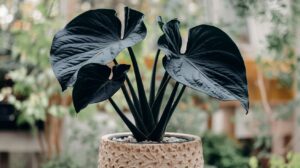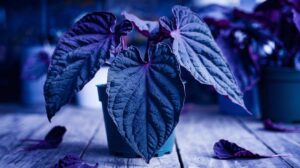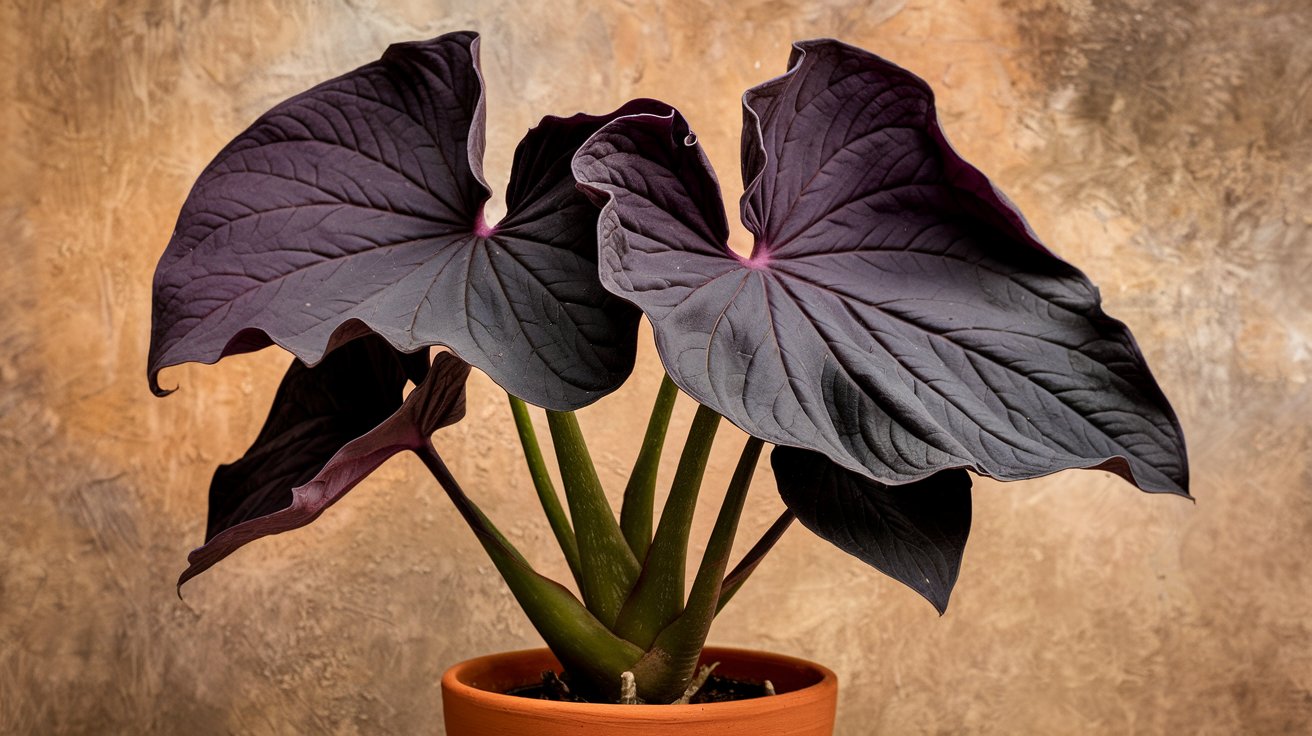This black elephant ear plant ( Colocasia esculenta) is known for its dramatic, large and dark-colored leaves is a favorite choice for gardeners who want to add a dramatic tropical look to their indoor and outdoor areas. The stunning plant thrives in humid and warm conditions and can reach massive dimensions. In this thorough guide, we’ll go over all you must be aware of concerning this Black Elephant Ear plant, from the planting and maintenance tips to more common problems and propagation techniques.
What Is the Black Elephant Ear Plant?
It is the black elephant ear plant is part of the Colocasia family that is indigenous to tropical regions. It is named after its huge heart-shaped leaves, which look like elephant ears. What makes this “Black Elephant Ear“ distinct is the rich purple-black foliage which creates striking contrast to gardens. The plant is usually used for decorative purposes and is often the focal point of any landscaping design.
Why Choose the Black Elephant Ear Plant?
Selecting the Plant called Black Elephant Ear is a great choice for gardeners seeking to make an impact. Its large leaves and striking shades add interest and class to patios, gardens, as well as indoor areas. This is why it stands out:
- Unique appearance The lush dark foliage is different from many plants, giving an exotic and luxurious feel.
- Flexibility The plant can be planted in pots, gardens or even in a pot for a home plant when it is treated with care.
- Low maintenance When established, this plant will be quite easy to take care of.
How to Plant the Black Elephant Ear Plant

1. Choosing the Right Location
When you are planting the Black Elephant Ear plant It is essential to select the perfect spot which is suited to its requirements. The is a plant that thrives light that is from partial to total however, it prefers filtering sunlight in very hot climates to prevent the leaves from burning.
- outdoor planting Pick a place which receives morning sun and some shade during the hottest time in the morning.
- Indoor planting Plant the plant close to an large, indirect lighting source. Avoid direct sunlight because it can cause burns to the leaves.
2. Soil Requirements
Black Elephant Ear Black Elephant Ear plant thrives in well-drained, moist soil with a high content of organic matter. For the best results, take into consideration the following requirements for soil:
- pH level The soil must have a pH range in the range of 5.5 to 7.0.
- Drainage While the plant is a fan of moist soil it shouldn’t be drenched in water. A well-drained soil can prevent root rot.
3. Planting Depth and Spacing
When you plant bulbs for the Black Elephant Ear be sure to plant them at the appropriate depth and leave enough space
- Depth The bulbs should be planted up to 6 inches deep.
- Spacing Space plants between 2 and 3 feet apart, to allow for the huge leaves.
Caring for the Black Elephant Ear Plant
1. Watering
The Black Elephant Ear plant requires constant irrigation especially throughout the growth season. Make sure the soil stays wet, but not too soggy. This is how you can water it properly:
- outdoor plants The best way to water your plants is 2-3 times per week. Intensify watering when it is hot and dry.
- Indoor plants Water them at the point where the soil’s top inch appears dry. Be careful not to overwater, as this could cause root rot.
2. Fertilizing
To promote healthy growth and bright leaves to encourage healthy growth, nourish the Black Elephant Ear plant frequently throughout the growing season.
- The type of fertilizer Choose an fertiliser that is balanced that contains equal amounts of nitrogen, phosphorus and potassium.
- Frequency Apply fertilizer every four to six weeks in the summer and spring. Cut down on feeding during the winter and fall when the plant is in dormancy.
3. Temperature and Humidity
The Black Elephant Ear plant thrives in humid, warm environments. To ensure optimal growth,
- Temperature Keep temperatures between 65degF to 85degF.
- Humidity When growing indoors, you can increase the amount of humidity by misting leaves frequently or by using the humidifier.
4. Pruning
While this Black Elephant Ear plant is not in need of heavy pruning, it will require regular maintenance to keep it looking great:
- Get rid of dead leaves Remove dead or yellow leaves to encourage new growth.
- Cut back in winter In warmer climates cut the plant back in the fall, to get ready for winter.
Propagating the Black Elephant Ear Plant
Growing The Plant Black Elephant Ear is fairly simple and is done via division or bulb planting.
1. Division
The most popular way to propagate.
- Step 1. Begin by gently digging up the plant while making sure that you don’t harm the roots.
- Second step 2: Split the bulbs into clumps or corms by using a sharp and sterilized knife.
- Step 3. Replant the divisions into well-drained, moist soil. make sure to water the area thoroughly.
2. Bulb Planting
It is also possible to propagate this plant through the planting of its bulbs:
- Step 1. Harvest bulbs from mature plants in the autumn.
- Step 2. 2. Store your bulbs in a dry, cool location in the winter.
- Step 3. 3: Plant the bulbs in the spring time to allow for growth.
Common Problems and Solutions
1. Pests
This black elephant ear plant is vulnerable to insects such as spider mites, aphids as well as mealybugs.. To stop the spread of these pests:
- Make use of insecticidal soap The plant should be treated using insecticidal soap, or neem oil.
- Get rid of infested leaves Inspect the leaves and take away any that show evidence of an infestation.
2. Yellowing Leaves

Yellowing leaves are a frequent problem for black elephant ear plants and may be caused by a variety of reasons:
- Overwatering Check that the plant isn’t in soil that has been soaked with water.
- Insufficient nutrients Give the plants a well-balanced fertilizer in order to solve deficiencies in nutrient.
3. Root Rot
Root rot happens when plants are exposed to excessive humidity. To stop this from happening:
- Make sure that the drainage is proper Make sure the soil is adequately drained, and try to avoid overwatering.
Can You Grow Black Elephant Ear Indoors?
Yes you can, it is true that the Plant known as the Black Elephant Ear is able to be grown in indoors, provided you take the proper attention. Here’s how to make sure it succeeds:
- Select the right pot Make sure you use a big pot with drainage holes in order to allow for the plant’s root system to.
- Humidity Keep the humidity level to a high indoor by regularly misting the plant.
- Light Place the plant in a location that receives the bright, indirect light.
Conclusion
It is the black elephant ear plant is a stunning design for your garden or house. Its stunning foliage and low maintenance this plant is ideal for gardeners who wish to bring a hint of tropical to their garden. Following the suggestions outlined in this article that will ensure healthy and lush development from the black elephant ear for a long time to be.

